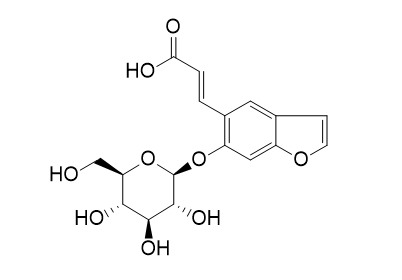trans-Psoralenoside
Trans-Psoralenoside has hepatoprotective, kidney protection, antiulcer and anticoagulant activities.
Inquire / Order:
manager@chemfaces.com
Technical Inquiries:
service@chemfaces.com
Tel:
+86-27-84237783
Fax:
+86-27-84254680
Address:
1 Building, No. 83, CheCheng Rd., Wuhan Economic and Technological Development Zone, Wuhan, Hubei 430056, PRC
Providing storage is as stated on the product vial and the vial is kept tightly sealed, the product can be stored for up to
24 months(2-8C).
Wherever possible, you should prepare and use solutions on the same day. However, if you need to make up stock solutions in advance, we recommend that you store the solution as aliquots in tightly sealed vials at -20C. Generally, these will be useable for up to two weeks. Before use, and prior to opening the vial we recommend that you allow your product to equilibrate to room temperature for at least 1 hour.
Need more advice on solubility, usage and handling? Please email to: service@chemfaces.com
The packaging of the product may have turned upside down during transportation, resulting in the natural compounds adhering to the neck or cap of the vial. take the vial out of its packaging and gently shake to let the compounds fall to the bottom of the vial. for liquid products, centrifuge at 200-500 RPM to gather the liquid at the bottom of the vial. try to avoid loss or contamination during handling.
J Cell Mol Med.2021, 25(5):2645-2654.
Cell Physiol Biochem.2019, 52(6):1255-1266
Food Funct.2022, 13(23):12105-12120.
Agriculture.2024, 69(3):140-148.
Sci Rep.2023, 13(1):14594.
Molecules.2023, 28(8):3414.
J Ethnopharmacol.2023, 313:116534.
Phytomedicine.2019, 58:152893
Chemistry of Natural Compounds2020, 56,423-426
Chin J Appl. Physiol.2019, 35(3):283-288
Related and Featured Products
Saudi Pharm J . 2014 Nov;22(5):460-71
Phytochemical and pharmacological study of Ficus palmata growing in Saudi Arabia[Pubmed:
25473335]
Phytochemical study of the aerial parts of Ficus palmata utilizing liquid-liquid fractionation and different chromatographic techniques resulted in the isolation of a new isomer of psoralenoside namely, trans-Psoralenoside (5) in addition to, one triterpene: germanicol acetate (1), two furanocoumarins: psoralene (2), bergapten (3), one aromatic acid vanillic acid (4) and the flavone glycoside rutin (6). Structures of the isolated compounds were established through physical, 1D- and 2D-NMR and MS data. The total extract and fractions of the plant were examined in vivo for its possible effects as hepatoprotective, nephroprotective, antiulcer and anticoagulant activities in comparison with standard drugs. Hepatoprotective activity was assessed via serum biochemical parameters including aspartate aminotransferase (AST), alanine aminotransferase (ALT), gamma glutamyl transpeptidase (GGT), alkaline phosphatase (ALP) and total bilirubin. Tissue parameters such as non-protein sulfhydryl groups (NP-SH), malonaldehyde (MDA) and total protein (TP) were also measured. In addition to tissue parameters, nephroprotective effect was evaluated by measuring the serum levels of sodium, potassium, creatinine and urea. Histopathological study for both liver and kidney cells was also conducted. Antiulcer activity was explored by observing stomach lesions after treatment with ethanol. Whole blood clotting time (CT) was taken as a measure for the anticoagulant activity of the extract. Antioxidant activity of the total extract and fractions of the plant was measured using 2,2-diphenyl-1-picrylhydrazyl (DPPH) method and ascorbic acid as standard.
Saudi Pharm J. 2014 Nov;22(5):460-471.
Phytochemical and pharmacological study of Ficus palmata growing in Saudi Arabia[Pubmed:
25473335]
Phytochemical study of the aerial parts of Ficus palmata utilizing liquid-liquid fractionation and different chromatographic techniques resulted in the isolation of a new isomer of psoralenoside namely, trans-Psoralenoside (5) in addition to, one triterpene: germanicol acetate (1), two furanocoumarins: psoralene (2), bergapten (3), one aromatic acid vanillic acid (4) and the flavone glycoside rutin (6). Structures of the isolated compounds were established through physical, 1D- and 2D-NMR and MS data. The total extract and fractions of the plant were examined in vivo for its possible effects as hepatoprotective, nephroprotective, antiulcer and anticoagulant activities in comparison with standard drugs. Hepatoprotective activity was assessed via serum biochemical parameters including aspartate aminotransferase (AST), alanine aminotransferase (ALT), gamma glutamyl transpeptidase (GGT), alkaline phosphatase (ALP) and total bilirubin. Tissue parameters such as non-protein sulfhydryl groups (NP-SH), malonaldehyde (MDA) and total protein (TP) were also measured. In addition to tissue parameters, nephroprotective effect was evaluated by measuring the serum levels of sodium, potassium, creatinine and urea. Histopathological study for both liver and kidney cells was also conducted. Antiulcer activity was explored by observing stomach lesions after treatment with ethanol. Whole blood clotting time (CT) was taken as a measure for the anticoagulant activity of the extract. Antioxidant activity of the total extract and fractions of the plant was measured using 2,2-diphenyl-1-picrylhydrazyl (DPPH) method and ascorbic acid as standard.
Saudi Pharm J. 2014 Nov;22(5):460-471.
Phytochemical and pharmacological study of Ficus palmata growing in Saudi Arabia[Pubmed:
25473335]
Phytochemical study of the aerial parts of Ficus palmata utilizing liquid-liquid fractionation and different chromatographic techniques resulted in the isolation of a new isomer of psoralenoside namely, trans-Psoralenoside (5) in addition to, one triterpene: germanicol acetate (1), two furanocoumarins: psoralene (2), bergapten (3), one aromatic acid vanillic acid (4) and the flavone glycoside rutin (6). Structures of the isolated compounds were established through physical, 1D- and 2D-NMR and MS data. The total extract and fractions of the plant were examined in vivo for its possible effects as hepatoprotective, nephroprotective, antiulcer and anticoagulant activities in comparison with standard drugs. Hepatoprotective activity was assessed via serum biochemical parameters including aspartate aminotransferase (AST), alanine aminotransferase (ALT), gamma glutamyl transpeptidase (GGT), alkaline phosphatase (ALP) and total bilirubin. Tissue parameters such as non-protein sulfhydryl groups (NP-SH), malonaldehyde (MDA) and total protein (TP) were also measured. In addition to tissue parameters, nephroprotective effect was evaluated by measuring the serum levels of sodium, potassium, creatinine and urea. Histopathological study for both liver and kidney cells was also conducted. Antiulcer activity was explored by observing stomach lesions after treatment with ethanol. Whole blood clotting time (CT) was taken as a measure for the anticoagulant activity of the extract. Antioxidant activity of the total extract and fractions of the plant was measured using 2,2-diphenyl-1-picrylhydrazyl (DPPH) method and ascorbic acid as standard.



